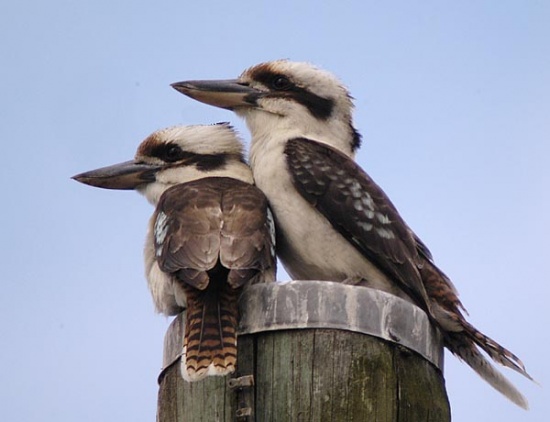BigRedBirder (talk | contribs) |
|||
| Line 3: | Line 3: | ||
[[Image:Laughing_Kookaburra.jpg|thumb|550px|right|Photo by Neil Fifer]] | [[Image:Laughing_Kookaburra.jpg|thumb|550px|right|Photo by Neil Fifer]] | ||
==Identification== | ==Identification== | ||
| − | 40 - 45 cm | + | L. 40-45 cm |
| + | *Off-white below with faint dark brown barring | ||
| + | *Brown on back and wings | ||
| + | *Rufous tail, broadly barred with black | ||
| + | *Dark brown eye-stripe | ||
| + | *Mottled blue on wings | ||
| − | + | Massive bill is 5-6 cm long. | |
| + | |||
| + | Sexes similar. | ||
==Distribution== | ==Distribution== | ||
| Line 12: | Line 19: | ||
==Taxonomy== | ==Taxonomy== | ||
| − | Largest member of the kingfisher family Alcedinidae. | + | Largest member of the kingfisher family ''Alcedinidae''. |
==Habitat== | ==Habitat== | ||
Open forests and woodlands. | Open forests and woodlands. | ||
==Behaviour== | ==Behaviour== | ||
| − | Diet | + | ====Diet==== |
| + | Includes insects, worms and crustaceans, small snakes, mammals, frogs and birds. | ||
Small prey is eaten whole, but larger prey is killed by hitting it against the ground or tree branch. | Small prey is eaten whole, but larger prey is killed by hitting it against the ground or tree branch. | ||
| − | + | ====Breeding==== | |
The nest is a bare chamber in a tree hollow or in a burrow excavated in a termite mound. Both sexes share the incubation duties and both care for the young. | The nest is a bare chamber in a tree hollow or in a burrow excavated in a termite mound. Both sexes share the incubation duties and both care for the young. | ||
| − | + | ==Voice== | |
| + | ====Song==== | ||
| + | ''koo-koo-koo-koo-koo-kaa-kaa-kaa'' | ||
==External Links== | ==External Links== | ||
{{GSearch|Dacelo+novaeguineae}} | {{GSearch|Dacelo+novaeguineae}} | ||
*[http://www.aviceda.org/abid/birdimages.php?action=birdspecies&fid=15&bid=82 View more images of this species on the ABID] | *[http://www.aviceda.org/abid/birdimages.php?action=birdspecies&fid=15&bid=82 View more images of this species on the ABID] | ||
[[Category:Birds]] | [[Category:Birds]] | ||
Revision as of 14:45, 25 January 2008
- Dacelo novaeguineae
Identification
L. 40-45 cm
- Off-white below with faint dark brown barring
- Brown on back and wings
- Rufous tail, broadly barred with black
- Dark brown eye-stripe
- Mottled blue on wings
Massive bill is 5-6 cm long.
Sexes similar.
Distribution
Eastern Australia. Woodlands and open forest, Cape York Peninsula to Eyre Peninsula. Introduced and established in Tasmania and southwestern Western Australia.
Taxonomy
Largest member of the kingfisher family Alcedinidae.
Habitat
Open forests and woodlands.
Behaviour
Diet
Includes insects, worms and crustaceans, small snakes, mammals, frogs and birds. Small prey is eaten whole, but larger prey is killed by hitting it against the ground or tree branch.
Breeding
The nest is a bare chamber in a tree hollow or in a burrow excavated in a termite mound. Both sexes share the incubation duties and both care for the young.
Voice
Song
koo-koo-koo-koo-koo-kaa-kaa-kaa




